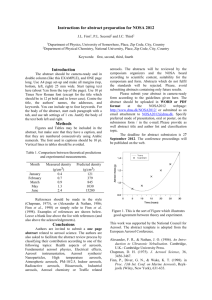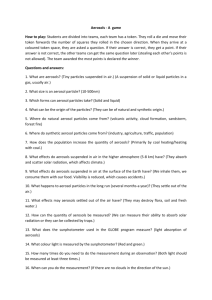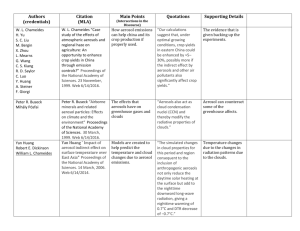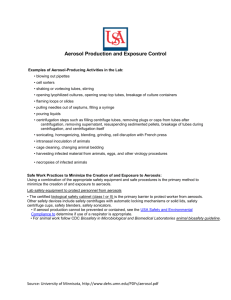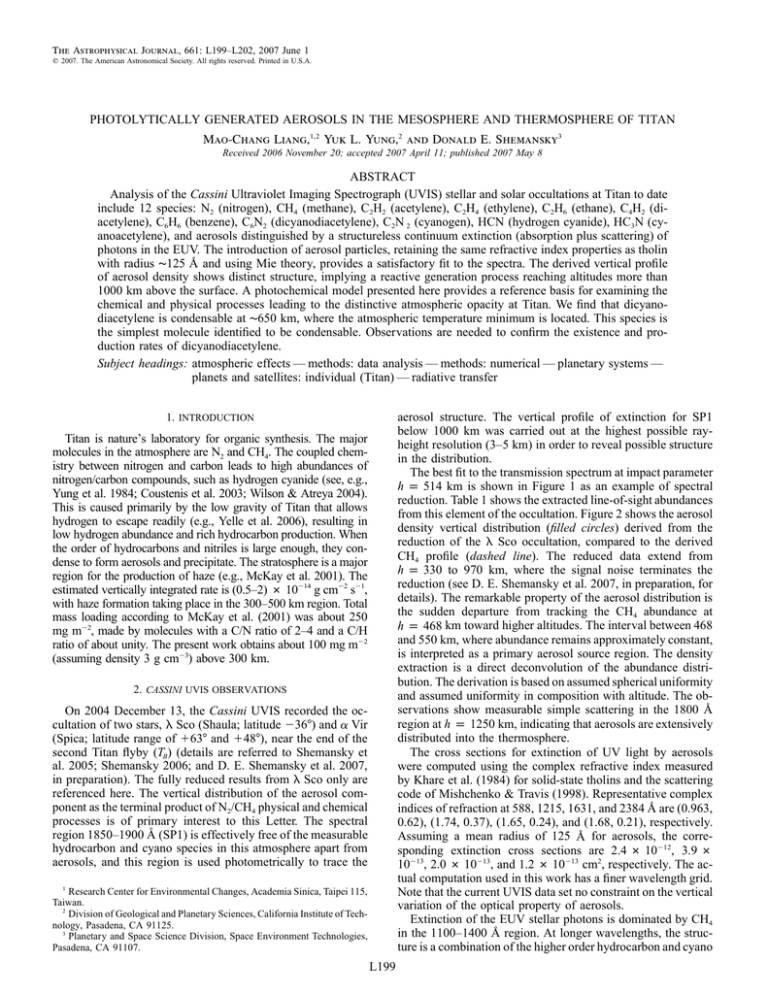
The Astrophysical Journal, 661: L199–L202, 2007 June 1
䉷 2007. The American Astronomical Society. All rights reserved. Printed in U.S.A.
PHOTOLYTICALLY GENERATED AEROSOLS IN THE MESOSPHERE AND THERMOSPHERE OF TITAN
Mao-Chang Liang,1,2 Yuk L. Yung,2 and Donald E. Shemansky3
Received 2006 November 20; accepted 2007 April 11; published 2007 May 8
ABSTRACT
Analysis of the Cassini Ultraviolet Imaging Spectrograph (UVIS) stellar and solar occultations at Titan to date
include 12 species: N2 (nitrogen), CH4 (methane), C2H2 (acetylene), C2H4 (ethylene), C2H6 (ethane), C4H2 (diacetylene), C6H6 (benzene), C6N2 (dicyanodiacetylene), C2N 2 (cyanogen), HCN (hydrogen cyanide), HC3N (cyanoacetylene), and aerosols distinguished by a structureless continuum extinction (absorption plus scattering) of
photons in the EUV. The introduction of aerosol particles, retaining the same refractive index properties as tholin
with radius ∼125 Å and using Mie theory, provides a satisfactory fit to the spectra. The derived vertical profile
of aerosol density shows distinct structure, implying a reactive generation process reaching altitudes more than
1000 km above the surface. A photochemical model presented here provides a reference basis for examining the
chemical and physical processes leading to the distinctive atmospheric opacity at Titan. We find that dicyanodiacetylene is condensable at ∼650 km, where the atmospheric temperature minimum is located. This species is
the simplest molecule identified to be condensable. Observations are needed to confirm the existence and production rates of dicyanodiacetylene.
Subject headings: atmospheric effects — methods: data analysis — methods: numerical — planetary systems —
planets and satellites: individual (Titan) — radiative transfer
aerosol structure. The vertical profile of extinction for SP1
below 1000 km was carried out at the highest possible rayheight resolution (3–5 km) in order to reveal possible structure
in the distribution.
The best fit to the transmission spectrum at impact parameter
h p 514 km is shown in Figure 1 as an example of spectral
reduction. Table 1 shows the extracted line-of-sight abundances
from this element of the occultation. Figure 2 shows the aerosol
density vertical distribution (filled circles) derived from the
reduction of the l Sco occultation, compared to the derived
CH4 profile (dashed line). The reduced data extend from
h p 330 to 970 km, where the signal noise terminates the
reduction (see D. E. Shemansky et al. 2007, in preparation, for
details). The remarkable property of the aerosol distribution is
the sudden departure from tracking the CH4 abundance at
h p 468 km toward higher altitudes. The interval between 468
and 550 km, where abundance remains approximately constant,
is interpreted as a primary aerosol source region. The density
extraction is a direct deconvolution of the abundance distribution. The derivation is based on assumed spherical uniformity
and assumed uniformity in composition with altitude. The observations show measurable simple scattering in the 1800 Å
region at h p 1250 km, indicating that aerosols are extensively
distributed into the thermosphere.
The cross sections for extinction of UV light by aerosols
were computed using the complex refractive index measured
by Khare et al. (1984) for solid-state tholins and the scattering
code of Mishchenko & Travis (1998). Representative complex
indices of refraction at 588, 1215, 1631, and 2384 Å are (0.963,
0.62), (1.74, 0.37), (1.65, 0.24), and (1.68, 0.21), respectively.
Assuming a mean radius of 125 Å for aerosols, the corresponding extinction cross sections are 2.4 # 10⫺12, 3.9 #
10⫺13, 2.0 # 10⫺13, and 1.2 # 10⫺13 cm2, respectively. The actual computation used in this work has a finer wavelength grid.
Note that the current UVIS data set no constraint on the vertical
variation of the optical property of aerosols.
Extinction of the EUV stellar photons is dominated by CH4
in the 1100–1400 Å region. At longer wavelengths, the structure is a combination of the higher order hydrocarbon and cyano
1. INTRODUCTION
Titan is nature’s laboratory for organic synthesis. The major
molecules in the atmosphere are N2 and CH4. The coupled chemistry between nitrogen and carbon leads to high abundances of
nitrogen/carbon compounds, such as hydrogen cyanide (see, e.g.,
Yung et al. 1984; Coustenis et al. 2003; Wilson & Atreya 2004).
This is caused primarily by the low gravity of Titan that allows
hydrogen to escape readily (e.g., Yelle et al. 2006), resulting in
low hydrogen abundance and rich hydrocarbon production. When
the order of hydrocarbons and nitriles is large enough, they condense to form aerosols and precipitate. The stratosphere is a major
region for the production of haze (e.g., McKay et al. 2001). The
estimated vertically integrated rate is (0.5–2) # 10⫺14 g cm⫺2 s⫺1,
with haze formation taking place in the 300–500 km region. Total
mass loading according to McKay et al. (2001) was about 250
mg m⫺2, made by molecules with a C/N ratio of 2–4 and a C/H
ratio of about unity. The present work obtains about 100 mg m⫺2
(assuming density 3 g cm⫺3) above 300 km.
2. CASSINI UVIS OBSERVATIONS
On 2004 December 13, the Cassini UVIS recorded the occultation of two stars, l Sco (Shaula; latitude ⫺36⬚) and a Vir
(Spica; latitude range of ⫹63⬚ and ⫹48⬚), near the end of the
second Titan flyby (TB) (details are referred to Shemansky et
al. 2005; Shemansky 2006; and D. E. Shemansky et al. 2007,
in preparation). The fully reduced results from l Sco only are
referenced here. The vertical distribution of the aerosol component as the terminal product of N2/CH4 physical and chemical
processes is of primary interest to this Letter. The spectral
region 1850–1900 Å (SP1) is effectively free of the measurable
hydrocarbon and cyano species in this atmosphere apart from
aerosols, and this region is used photometrically to trace the
1
Research Center for Environmental Changes, Academia Sinica, Taipei 115,
Taiwan.
2
Division of Geological and Planetary Sciences, California Institute of Technology, Pasadena, CA 91125.
3
Planetary and Space Science Division, Space Environment Technologies,
Pasadena, CA 91107.
L199
L200
LIANG, YUNG, & SHEMANSKY
Fig. 1.—The transmission spectrum of the UVIS l Sco occultation integrated
over the impact parameter 514–537 km (thin solid line), compared to the bestfit synthesis (D. E. Shemansky et al. 2007, in preparation) using the combined
identified species (thick solid line) and to model C from the present physical
chemistry code (dashed line). The dotted line shows the aerosol component
combined with the CH4 absorber in this reduction. The CH4 absorber (l !
˚ ) is included with aerosol here as a means of including a large part of
1490 A
the impact of the instrument point-spread function on the fitting process. The
optical depth in region SP1 is entirely attributed to aerosol extinction; the small
difference between the observed data and the aerosol component at SP1 is an
artifact of the UVIS EUV instrument point-spread function. The abundances
of the species for this case are given in Table 1 (see text).
species. The C6H6 cross section peaks at 1759.9–1815.1 Å,
blended primarily with C2H4. Dicyanodiacetylene has a cross
section peak in the SP1 spectral region. Dicyanodiacetylene
and benzene have not been detected in the absorption spectra
(D. E. Shemansky et al. 2007, in preparation). Aerosol extinction is detectable at ∼970 km in the transmission spectra and
dominates all absorbers at all wavelengths in the UVIS except
for CH4, at altitudes below 400–450 km.
Figure 1 shows the contribution of aerosol extinction to the
total measured optical depth at 514 km. In the spectral region
SP1 aerosol extinction is entirely responsible for the optical
depth. The measurable spectral region for extracting the aerosol
Vol. 661
Fig. 2.—Aerosol density (filled circles) derived from the UVIS l Sco occultation compared to the CH4 (dashed line) scaled by 10⫺9 (Shemansky et al.
2005; Shemansky 2006). The increase of the mixing ratio of the UVIS aerosols
through the mesosphere to at least 1000 km implies that the production of
aerosols must take place at significant rates throughout the mesosphere and
thermosphere. The UVIS-derived temperature profile is shown by the dotted
line, which reflects a correction to the one presented by Shemansky et al.
(2005). The model aerosol profiles are shown by the thin and thick solid lines
(see text). The over- and underestimations are due to the fact that we assume
a constant sedimentation velocity of 0.25 cm s⫺1, calculated at 535 km (Cabane
et al. 1992).
component is 1500–1900 Å, where the wavelength dependence
of extinction shows a proportionality to l⫺1.5 . The Voyager and
Cassini photometric observations in the UV spectral region
(Porco et al. 2005; West et al. 2006) have revealed the presence
of detached haze layers at Titan. The Cassini results show the
presence of a latitudinally uniform detached layer near 500 km
in forward-scattered 3380 Å photons. The relationship of this
phenomenon to the aerosols identified here requires further
investigation. A comparison to Voyager results (Smith et al.
1982) shows that the major differences are that the apparent
strong extinction by aerosols takes effect about 100 km higher
for Voyager and that significantly more extinction is evident
for Voyager in the 700–1000 km region. The Voyager data
show a broad extinction maximum near 770 km.
TABLE 1
Summary of Model Results
Molecule
Cassini
Model A
Model B
Model C
Model D
WA04
N2 (#1021) . . . . . . . . . .
CH4 (#1019) . . . . . . . .
C2H2 (#1017) . . . . . . . .
C2H4 (#1016) . . . . . . . .
C2H6 (#1016) . . . . . . . .
HCN (#1017) . . . . . . .
C4H2 (#1015) . . . . . . . .
C6N2 (#1014) . . . . . . . .
C6H6 (#1014) . . . . . . . .
HC3N (#1015) . . . . . . .
C2N2 (#1015) . . . . . . . .
Tholin (#1011) . . . . . .
5.8
6.0
2.1
4.0
7.0
1.0
4.5
!1.0
!1.4
!3.9
!4.0
4.6
5.8
15
15
9.3
200
5.6
59
15
18
27
0.84
…
5.8
9.4
9.1
5.7
110
3.7
37
16
13
25
1.2
…
5.8
9.5
1.9
4.0
17
0.69
12
5.7
12
6.9
0.34
…
5.8
9.7
1.7
2.0
9.2
0.53
2.1
8.0
0.041
7.8
0.42
…
5.8
13
1.5
3.4
20
0.017
41
…
0.21
0.96
0.00035
…
Notes.—Values are line-of-sight column-integrated abundances, in units of molecules cm⫺2,
reported by matching the observed N2 abundance. Model A: Hydrostatic atmosphere. Model B:
Nonhydrostatic atmosphere, an ad hoc downward wind, and extinction due to the derived tholins
are assumed (see text). Model C: Same as model B, but with additional sinks for the tabulated
nine photochemical species (see text). Model D: Same as model C, but with the updated hydrocarbon chemistry from Moses et al. (2005). WA04: Model results from Wilson & Atreya (2004).
Note that, in this Letter, the microphysical processes of C6N2 are not solved self-consistently,
and hence the tabulated abundances of C6N2 do not reflect the removal by condensation.
No. 2, 2007
HAZE ON TITAN
L201
TABLE 2
Chemical Reactions to C6N2
Label
R454
R455
R456
R492
R495
R496
R497
R498
......
......
......
......
......
......
......
......
Reactants
Products
Reactionsa
HC5N ⫹ hn
HC5N ⫹ hn
C6N2 ⫹ hn
C3N ⫹ HC3N
CN ⫹ C4H2
CN ⫹ HC5N
C5N ⫹ CH4
C5N ⫹ C2H6
C4H ⫹ CN
C5N ⫹ H
C5N ⫹ CN
C6N2 ⫹ H
HC5N ⫹ H
C6N2 ⫹ H
HC5N ⫹ CH3
HC5N ⫹ C2H5
J(HC3N ⫹ hn r C2H ⫹ CN)
J(HC3N ⫹ hn r C3N ⫹ H)
J(C4N2 ⫹ hn r C3N ⫹ CN)
k(C2H ⫹ C2H2 r C4H2 ⫹ H)
k(CN ⫹ C2H2 r HC3N ⫹ H)
k(CN ⫹ HC3N r C4N2 ⫹ H)
k(C3N ⫹ CH4 r HC3N ⫹ CH3)
k(C3N ⫹ C2H6 r HC3N ⫹ C2H5)
Rate Coefficientsb
1.8
3.3
3.0
8.6
2.3
1.0
5.0
1.0
#
#
#
#
#
#
#
#
10⫺8
10⫺8
10⫺7
10⫺16T1.8e474/T
10⫺11
10⫺11
10⫺14
10⫺11
Ref.
1
1
2
3
2
2
2
2
References.—(1) Lebonnois et al. (2001) and Wilson & Atreya (2004); (2) Yung (1987); (3) Lebonnois et al.
(2001) and Opansky & Leone (1996).
a
Estimated from the quoted reactions. Units are s⫺1 for photolysis reactions (J) and cm3 s⫺1 for two-body reactions
(k). The photolysis rate coefficients are given at the top of the model atmosphere.
b
The values are taken from model C. T is the atmospheric temperature.
3. PHOTOCHEMICAL MODELING
Vertical profiles of the major species have been calculated
using a photochemical model. The photochemical reactions are
taken from Yung et al. (1984), Yung (1987), and Moses et al.
(2000). The chemical scheme to C6N2 is hypothesized to be
similar to that to C4N2, as derived by Yung (1987) and summarized in Table 2. The temperature profile is based on the
Cassini measurements (Fig. 2, dotted line). The vertical eddy
mixing profile is taken from Yung et al. (1984). The model
simulation is diurnally averaged at low latitude. The incident
UV flux is the mean between solar maximum and minimum.
Table 1 provides a summary of model results. Sensitivity to
the selection of hydrocarbon kinetics and that of kinetics and
vertical eddy coefficients are shown by models D and WA04,
respectively.
We fix the N2 abundance to that derived from the Cassini
measurements. The model starts with a hydrostatic atmosphere.
With the prescribed vertical diffusion coefficients and taking the
photolysis of CH4 into account, the abundance of CH4 is overestimated (see Table 1), compared with the measurements. To
bring the model into better agreement with the observations, we
introduce an ad hoc advection that transports species other than
Fig. 3.—Modeled (model C) vertical profiles for CH4 (thick solid line),
HC3N (dashed line), HCN (dash-dotted line), C6N2 (double–dot-dashed line),
and C6H6 (long-dashed line). The thin solid line represents modeled CH4 by
model A. The saturation density of C6N2 extrapolated from high-temperature
measurements (295–369 K; Saggiomo 1957) is shown by the dotted line. The
resulting H2 (3 # 10⫺3) and CH4 (2.3%) mixing ratios at 1174 km and H2
escape flux (7 # 109 molecules cm⫺2 s⫺1) at the top are in good agreement
with the observations [(4 Ⳳ 1) # 10⫺3, 2.7% Ⳳ 0.1%, and (1.2 Ⳳ 0.2) #
1010 molecules cm⫺2 s⫺1, respectively; Yelle et al. 2006].
N2 downward. The wind is prescribed with strength proportional
to the inverse of the square root of atmospheric density. The
wind speed reaches ⫺20 cm s⫺1 at the top of the model atmosphere (∼1500 km). The assumed downward wind is qualitatively consistent with global circulation that has a downward
transport at mid to high latitudes (e.g., Lebonnois et al. 2001).
A comparison with modeled CH4 abundances between models
A and C is shown in Figure 3. We note that dynamics plays an
important role in distributing photochemical products (e.g., Lebonnois et al. 2001), especially in the regions above ∼500 km
(the regions of interest to this work) where the transport time is,
in general, shorter than the chemical removal time of hydrocarbon and cyano species (e.g., Wilson & Atreya 2004); current
simulations coupled with dynamics and photochemistry are limited to the regions below ∼400 km (Lebonnois et al. 2001). The
latitudinal variations of hydrocarbon and cyano abundances (e.g.,
Flasar et al. 2005) are the consequence of atmospheric transport
and photochemical processes.
The modeled profiles of HCN, HC3N, C6H6, and C6N2 are
presented in Figure 3. Calculated abundances are compared to
extraction from observation at 514 km in Table 1. Comparisons
between models and observations at other impact parameters
will be deferred to a later paper. The results for five variations
on the model at this impact parameter are given in Table 1. In
general, our base models (models A and B) overestimate the
abundances of hydrocarbons by as much as 10 times. An indication of the difference in the predicted model C and observed
optical depth spectra is shown in Figure 1. Model C (Table 1)
is too high relative to measured abundance in C2H6 and C4H2.
The modeled C6N2, C6H6, and HC3N are also well above the
upper limits set by observation. There are two ways of reducing
the abundances. (1) One way is through faster transport of
photochemical products to the lower atmosphere, as in the
model of Wilson & Atreya (2004; model WA04). Comparing
the transport time constant with the chemical destruction time,
the abundances of C2H2, C2H6, HCN, and C2N2 have a sensitivity to transport, and those of C2H4, C4H2, C6N2, C6H6, and
HC3N at ∼500 km are close to being in photochemical equilibrium (e.g., Wilson & Atreya 2004). (2) Another way is
through relatively rapid two-body physicochemical processes
forming aerosols as simulated in models C and D. The loss
rates in these models are assumed to be proportional to the
physical collision rates between aerosols (with radius 125 Å)
and molecules; adsorption reactions are assumed for all photochemical species listed in Table 1. The aerosol density is
from Figure 2. The adsorption efficiency for this absolute loss,
an assumed value of 0.01, yields the concentrations shown in
L202
LIANG, YUNG, & SHEMANSKY
Table 1. As described below, this process is required for explaining the aerosol abundance shown in Figure 2.
4. DISCUSSION
The source of aerosols has long been a puzzle in the atmosphere of Titan. It is generally believed that the synthesis of
increasingly complex hydrocarbon and nitrogen compounds
will eventually lead to saturation, resulting in coagulation and
precipitation. However, the chemical composition of the condensable species has not yet been established. In this Letter,
we propose that the simplest condensable compound is C6N2.
The abundances of the higher order species in the UVIS observations are significantly lower than the present model calculations. Assuming that the model conversion rates for the
CH4 source are basically correct, there is an implied loss rate
for these species that is substantially higher than the model
provides. The model calculation contains an absolute loss to
the measured aerosols using a conservatively small adsorption
probability. If a significant fraction of the implied loss is delivered to the production of aerosols, the model can be adjusted
by assuming a larger irreversible adsorption probability and a
consequent higher precipitation rate for the aerosols. This will
bring the model abundances into better conformance with observation but will not necessarily resolve differences in partitioning, and may not resolve issues raised in regard to rate
limits for the mass flow process that cycles to the surface. We
propose that the aerosol formation is initiated by the condensation of C6N2 and the adsorption to external meteoritic dust;
both serve as seeds for aerosol formation. The subsequent physical processes of adsorption on the existing aerosols and
(photo)chemistry converting these clusters into refractory tholins constitute the production and maintenance of the aerosol
distribution. Hunten (2006) has recently proposed that haze is
a major sink of ethane at Titan. The process of formation of
aerosols requires the stable adsorption of the higher order hydrocarbon and nitrile species.
The production rate of C6N2 in the model limits the production rate of aerosols from this direct path. The saturation
density of dicyanodiacetylene shown in Figure 3 shows that
condensation can take place between ∼550 and 800 km. The
Vol. 661
volume production rate of C6N2 in this region is quite uniform
(∼1 molecules cm⫺3 s⫺1); the column-integrated (550–800 km)
rate is ∼107 molecules cm⫺2 s⫺1, or ∼2 # 10⫺15 g cm⫺2 s⫺1. This
contribution is a small fraction of the total aerosol production
but is extremely important as a source of condensation nuclei.
The maximum rate of aerosol production, however, is set by the
total photolysis rate of CH4, which is on the order of 1010 molecules cm⫺2 s⫺1, or 2 # 10⫺13 g cm⫺2 s⫺1 of carbon, a result that
is independently corroborated by the H2 escape flux (Yelle et al.
2006). The rate of removal of molecules by the existing particles
in model C is close to this maximum rate. However, the resulting
aerosol profile (thin solid line in Fig. 2) underestimates the observed aerosol abundances above ∼800 km, suggesting an additional source at the top of the atmosphere, equivalent to a
downward flux of 5 # 10⫺14 g cm⫺2 s⫺1 (thick solid line). This
flux is consistent with that inferred from the Cassini Ion Neutral
Mass Spectrometer measurements (Waite et al. 2007) on the basis
of ion chemistry not considered here. Note that a sedimentation
velocity of 0.25 cm s⫺1 has to be imposed in order to match the
observed aerosol profile; this implies that the radius of the aerosols must be ∼125 Å in the mesosphere and thermosphere.
We emphasize that there are significant uncertainties in rate
process quantities and that stronger constraints are needed. Laboratory measurements for the adsorption rates on aerosols in
collision with the high-order molecules are required to verify
this process and to provide a better constraint to the aerosol
mass loading in the atmosphere of Titan. In addition, the photochemical paths to high-order hydrocarbon and nitrile compounds such as C6N2 and C6H6 are speculative. Atmospheric
dynamics in the mesosphere of Titan also plays a central role
in molecule/aerosol mixing. Further laboratory measurements
and Cassini observations will provide us with valuable information for refining our understanding of the chemical, dynamical, and microphysical processes in the atmosphere of Titan.
This research was supported by NASA grant NNG06GF33G
and Cassini grant JPL.1256000 to the California Institute of
Technology. D. E. S. acknowledges support from NASA grant
NNG06GH76G and from Cassini UVIS Program contract
1531660 to Space Environment Technologies.
REFERENCES
Cabane, M., Chassefiere, E., & Israel, G. 1992, Icarus, 96, 176
Coustenis, A., Salama, A., Schulz, B., Ott, S., Lellouch, E., Encrenaz, T.,
Gautier, D., & Feuchtgruber, H. 2003, Icarus, 161, 383
Flasar, F. M., et al. 2005, Science, 308, 975
Hunten, D. M. 2006, Nature, 443, 669
Khare, B. N., Sagan, C., Arakawa, E. T., Suits, F., Callcott, T. A., & Williams,
M. W. 1984, Icarus, 60, 127
Lebonnois, S., Toublanc, D., Hourdin, F., & Rannou, P. 2001, Icarus, 152, 384
McKay, C. P., Coustenis, A., Samuelson, R. E., Lemmon, M. T., Lorenz, R. D.,
Cabane, M., Rannou, P., & Drossart, P. 2001, Planet. Space Sci., 49, 79
Mishchenko, M. I., & Travis, L. D. 1998, J. Quant. Spectrosc. Radiat. Transfer,
60, 309
Moses, J. I., Bezard, B., Lellouch, E., Gladstone, G. R., Feuchtgruber, H., &
Allen, M. 2000, Icarus, 143, 244
Moses, J. I., Fouchet, T., Bezard, B., Gladstone, G. R., Lellouch, E. & Feuchtgruber, H. 2005, J. Geophys. Res., 110, E08001
Opansky, B. J., & Leone, S. R. 1996, J. Phys. Chem., 100, 4888
Porco, C. C., et al. 2005, Nature, 434, 159
Saggiomo, A. J. 1957, J. Organic Chem., 22, 1171
Shemansky, D. E. 2006, in Abstracts of 36th COSPAR Scientific Assembly,
2006 July 16–23, Beijing, China (Paris: COSPAR), 2748
Shemansky, D. E., Stewart, A. I. F., West, R. A., Esposito, L. W., Hallett,
J. T., & Liu, X. M. 2005, Science, 308, 978
Smith, G. R., Strobel, D. F., Broadfoot, A. L., Sandel, B. R., Shemansky,
D. E., &Holberg, J. B. 1982, J. Geophys. Res., 87, 1351
Waite, J. H., Jr., Young, D. T., Cravens, T. E., Coates, A. J., Crary, F. J.,
Magee, B., & Westlake, J. 2007, Science, in press
West, R. A., et al. 2006, BAAS, 38, 22.02
Wilson, E. H., & Atreya, S. K. 2004, J. Geophys. Res., 109, E06002
Yelle, R. V., Borggren, N., de la Haye, V., Kasprzak, W. T., Niemann, H. B.,
Müller-Woodarg, I., & Waite, J. H., Jr. 2006, Icarus, 182, 567
Yung, Y. L. 1987, Icarus, 72, 468
Yung, Y. L., Allen, M., & Pinto, J. P. 1984, ApJS, 55, 465


